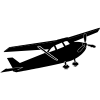Early detection and suppression of bushfires in WA’s forests

Photo by Daniel Jennings
Bushfires in Western Australia’s South West forests are managed by the Department of Biodiversity, Conservation and Attractions (DBCA). The department relies on widespread prescribed burning as the primary bushfire mitigation tool. However, due to changing climatic conditions, the prescribed burning program is failing to meet targets and has resulted in fires of much greater intensity, tree damage and biodiversity loss.
To prevent intense fires and biodiversity loss, DBCA must shift to a program that focuses on rapid detection and suppression strategies alongside First Nations-led cultural burning and targeted, low-intensity prescribed burns.
Bushfire detection and suppression in Southwest forests currently consists of
10 fire towers in the Southwest that are utilised by staff using binoculars during times of high fire danger.
The public calling 000 when a fire is spotted
Cub Scout fixed-wing aircraft that patrol forests during times of bad fire weather and helicopters based around population centres and planes in rural locations
Satellites detecting hotspots
A fleet of fire trucks and 4WD units and heavy machinery like bulldozers and loaders
The capacity to efficiently detect and suppress bushfires in WA’s forests can be improved
Earlier detection
Ultra early fire detection systems
Ultra early bushfire detection and forest monitoring systems are now available and can detect smouldering well before flames appear.
Air sensors linked to mobile networks placed throughout a forest can detect changes to the gas composition of the air and provide real-time data to forest managers.
These systems can provide the earliest possible warning to firefighters and may be most useful in discrete areas such as reserves close to towns.
Fire camera detection systems
Fire cameras have been deployed around the world and are used extensively in the eastern states with Queensland embracing the technology in 2002. Fire cameras provide many major advantages to firefighters including
- Fire cameras detect fires in all conditions compared to traditional fire towers and spotter planes, which can only detect fires when staffed and in good weather.
- Fire cameras can rotate every 3-6 seconds and have a range of 30 – 130 km and provide real-time data that is analysed by AI and can alert managers and fire crews instantly.
- Fire cameras feeding into analysis systems greatly improve situational awareness and provide managers and on-ground fire crews with vital information such as fire behaviour, the fastest routes and available equipment.
- The remotely controlled high-zoom cameras capture detailed 360-degree imagery, allowing for analysis of fire behaviour during and post fire. The cameras can even spot arsonists, yet blur private residences to alleviate privacy concerns.
Fire detection drones
Drones are now being used to detect bushfires as they start and can provide firefighters with real-time data on bushfire behaviour. There are many major advantages to using drone detection systems including
- Drones can be equipped with heat, smoke and gas detection.
- Drones are very effective at surveillance of high-risk areas day and night, providing intelligence whilst other aircraft are grounded or unavailable.
- Drones can confirm suspected ignitions (e.g. confirming that a smoke sighting is from a previously undetected fire) and facilitate accurate geolocation of new fires.
- Drones tracking a storm can fly over recent lightning strikes and validate whether ignition has occurred as soon as the storm passes.
- Information from drones can feed into analysis systems along with fire cameras to assist in response decisions.
- Drones can also act as temporary communications platforms for both ongoing fire management operations in remote areas and when infrastructure is damaged by fire.
Satellite detection technology
Data from thermal infrared sensors on satellites can detect ‘hotspots’ when they pass over fires.
A web-based platform provides data to agencies such as DBCA and others monitoring fire risk. However, the system relies on access to international satellite data streams which comes with time lags.
In comparison, the SA government launched their own satellite in 2024 with an onboard AI fire detection system capable of detecting fire smoke 500 times faster than traditional on-ground processing. Australian state and federal governments urgently need to invest in geostationary satellites that constantly monitor bushfire-prone areas.
Australian governments urgently need to provide funding for geostationary satellites that constantly monitor bushfire prone areas.
Fire weather forecasting
Accurate forecasting of approaching bad fire weather is essential for fire crews and residents to prepare for bushfires.
New AI software programs have been developed in QLD that analyse long-term and real-time weather data, including air temperature, relative humidity, wind speed, vapour pressure and dew point.
Fire weather forecasts can now be delivered with much greater accuracy in QLD.
In WA a greater network of Remote Automated Weather Stations is required along with AI fire analysis software to better inform fire preparedness and response across the region.
Faster suppresion
Water gliders & autonomous drones
Water gliders are being trialled in the ACT. Up to 30 water gliders can be dropped from a C-130 aircraft and can travel at 400 kph dropping around half a tonne of water each.
Combined with scout drones to provide accurate GPS locations of lightning strikes, water gliders can quickly and accurately suppress small bushfires.
Autonomous fire suppression drones are also available that utilise infrared cameras that can accurately target and extinguish small fires with inbuilt sonic cannons.
Aerial firefighting
Aerial firefighting technology has rapidly improved with greater ability to accurately target fires and assist ground crews.
Australia’s National Aerial Firefighting Centre has more than 500 aircraft available for firefighting, but most of the national fleet is based along the east coast.
In WA there are some helicopters based around population centres such as Busselton, Serpentine, Jandakot and Gingin, but these have limited use fighting remote forest fires. Planes are essential for forest fires due to their long range and speed with several based in Busselton. Albany currently has 2 air tractor crop dusters available throughout the summer fire period but these planes are normally used for spraying crops.
Other States like NSW have made a $400 million commitment to buy their own firefighting aircraft that will be available in NSW all year round.
WA urgently requires more firefighting aircraft and pilots based in strategic locations like Collie, Manjimup and Walpole to allow for rapid deployment to suppress forest fires when small.
On-ground firefighting
Current bushfire suppression equipment for Southwest forests consists of a fleet of fire trucks and light 4WD fire fighters, loaders and bulldozers.
There are many challenges to rapidly suppressing bushfires in forests, as access is difficult without readily available heavy machinery like bulldozers. WA’s forests also have widespread Phytophthora dieback (a plant-based disease), which requires machinery to be thoroughly cleaned before moving locations. Access to water is another limitation, but these problems can be overcome with better funding for more equipment and comprehensive planning.
Some of the ways we can improve on-ground bushfire suppression capacity in WA’s forests are
- More heavy equipment (bulldozers, loaders) be made available throughout the fire season in strategic locations
- Better planning and management of water points throughout forest areas
- More high-volume trailer-mounted water pumps for rapid refilling of water transport trucks and fire tankers
- Increased infrastructure funding for airports adjacent to forest areas for fire suppression aircraft and improved water supply for aerial firefighting
- Specialist tractor and mulcher equipment to undertake growth suppression and non-burn hazard reduction in key fire corridors.
- Greater emphasis on constructing fire trails and conducting strategic burns to create fire breaks around towns and infrastructure.
The WA Government can greatly improve bushfire detection and suppression capacity in WA’s forests with better funding and a greater focus on proven technologies and methods. Alongside First Nations-led cultural burning and small, cool and strategic prescribed burning these methods can protect lives, infrastructure and biodiversity from bushfires.





